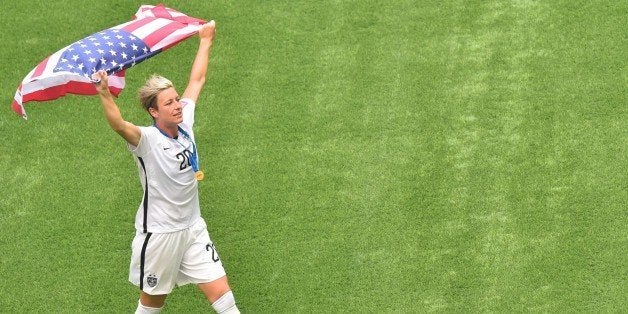
Cleats were part of my life before books. As a young female athlete, I learned to play soccer before kindergarten. Hooked from the moment my foot first kicked a ball, I've loved experiencing the benefits of being part of a team who wins, loses, attacks, defends, laughs, cries, and everything in between together.
Powerful female players such as Abby Wambach and Alex Morgan have long inspired me. These women seem like unstoppable, real-life Wonder Women. This year, I was glued to the TV while watching the World Cup where once again, Wambach and Morgan, as well as the rest of the fabulous USA Women's World Cup team, seemed as though they could conquer the world.
And they did. They emerged from this year's FIFA Women's World Cup with the champion's trophy, witnessed by over 25.4 million viewers, making it the most-watched soccer game in the history of American television.
Little did these 25.4 million people know, the elite female soccer players of America faced more than a few obstacles on their journey to the top, some of which were insurmountable. The most prominent problem of all, the value that the media and the world placed on their impressive work, impacted the players on multiple fields, including on the one the games took place on. And I quite literally mean the fields on which the games were played.
The introduction of artificial turf instead of grass fields has long been discussed, although no valid argument or real advantages of switching from grass to turf exists. This year, for the first time ever in the exciting history of men's and women's FIFA World Cups, the women's games were played on artificial turf, introducing a profusion of new issues that FIFA and the female players had never faced before. On the other hand, the men's World Cup games were played on lush and well-maintained grass.
To Abby Wambach, the United States' forward who now holds the record for the most international goals scored for both male and female players with 184 beautiful goals, transitioning to a turf playing field changed more than just the material under her feet. It changed the game. In the midst of the turf crisis, Wambach mentioned, "There's soccer on grass, then there's soccer on turf." She is completely correct: the artificial turf causes the ball to move faster across the pitch, interrupting the rhythm of the game, causing the ball to ricochet across the field, and making the game feel more like pinball than soccer.
The issues don't just stop there. While playing on turf, players are much more likely to get injured from either falling or sliding on the turf or from the increased stress the artificial field puts on their joints. For some female players, the thought of enduring turf burns, abrasions, and joint stress generated a fear of slide tackling, potentially impacting the aggression and intensity of the game. Further, due to the higher rate of injury while playing on turf, players will need additional recovery time between games.
But wait, there's more! Although not all turf is created equally, most artificial turf consists of small black beads of cut up tire called crumb rubber. Containing carcinogens and countless chemicals, exposure to crumb rubber causes multiple risks to players' health. For example, plentiful evidence exists to determine that crumb rubber exposure can lead to cancer. Ethan Zohn, a former goalkeeper who was diagnosed with Hodgkin's Lymphoma in 2009 has studied the connection between soccer players with cancer to their exposure to turf and crumb rubber. Among the 52 players with cancer he has studied, 46 of them have been goalkeepers, a position that has a higher interaction with turf than others.
Zohn says, "Goalkeepers are on the ground for the most part. Your face is in it, you're breathing in the dust, eating some of it, your scrapes are getting filled with this stuff." This isn't good, and common sense would infer that FIFA would want to minimize health risks for the most elite and competitive female soccer players in the world... right?
Wrong. Wambach, one of the most active critics involved in the turf issue, is one of 84 players representing 13 countries who filed a lawsuit against FIFA and the Canadian Soccer Association for the use of artificial turf and proposed gender discrimination. Wambach revealed that the Scotts Company and Sepp Blatter, the ex- FIFA president who resigned after the arrests of 9 FIFA officials, had the option to install grass fields when the official World Cup lawn care specialist offered to provide them in all venues, but FIFA refused.
Disappointed and frustrated, Alex Morgan, another unstoppable forward of the United States women's national team, explained, "If the men's World Cup didn't allow it, and they built brand new stadiums--not even put in grass fields, they built brand new stadiums with a couple billion dollars--you'd think we're worth the couple million to put in grass fields." That sums it up: our female players did not deserve this injustice.
Due to the outrage about turf fields changing the game and injuring players, the world soccer governing body promised that Women's World Cups will never again be played on turf fields. This decision is better late than never, but the fact that the 2015 Women's World Cup was on turf and the Men's World Cup was on grass is one of many indicators of the discrimination against women in sports.
To be sure, turf isn't the only greens where women athletes are losing out. Female World Cup athletes were awarded a mere $2 million compared to the massive $35 million prize for male players. To put this in perspective, the men's teams who lost in the first round of the 2014 World Cup took home $8 million. In other words, even the male losers earned four times more than our phenomenal female champions. Pathetic.
FIFA refused to stand up for the women. When Jérôme Valcke, the secretary general of FIFA, was confronted about the prize money discrimination, he simply said, "That's not even a question I will answer because it is nonsense... We are still another 23 World Cups before potentially women should receive the same amount as men." Now that's just insulting.
How can this Grand Canyon-sized wage gap happen when a women's game was just the most-watched soccer game in the history of American television? Well, this issue begins with a broad generalization that developed sometime in the prolonged history of sports broadcasting in television: men's sports are often seen by media companies as more exciting than women's.
While that's definitely not true, this is an opinion held by many media executives in particular (and women comprise less than 20% of all media executives). In fact, these modern-day media executives may give the viewers a reason to believe this: as Cheryl Cooky, a professor of women's studies at Purdue University, noted, "[Men's sports games] have higher production values, higher-quality coverage, and higher-quality commentary ... When you watch women's sports, and there are fewer camera angles, fewer cuts to shot, fewer instant replays, yeah, it's going to seem to be a slower game, [and] it's going to seem to be less exciting."
It gets worse. Last year, women's sports were only shown on ESPN's SportsCenter 2% of the time.
To solve this jurassic women's sports catastrophe, the media executives and the viewers have to eliminate the stigma and up their production values. Women's sports are in fact as exciting as men's, and I'm sure the 25.4 million viewers of this summer's Women's World Cup final would agree without hesitation.
Eliminating the stigma would not only boost the confidence and happiness of most female athletes, it would bring more money into women's sports through commercials and sponsors. It would also give FIFA a reason to change their fundamental philosophy that women's sports are less valuable and to fight for the women's rights next time an issue like the turf war arises.
With the Women's World Cup 2015 finals viewership breaking all records, it's time for FIFA to wake up and realize that the women who achieve the World Cup Champion title should be awarded at a level that would enable them to pay their bills. FIFA must recognize that they've been presented with an enormous opportunity to follow their mission statement and "develop football everywhere and for all."
And yes, the word "all" includes women.
